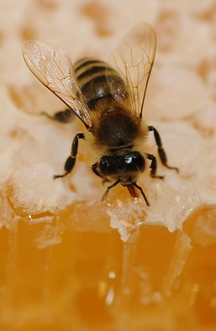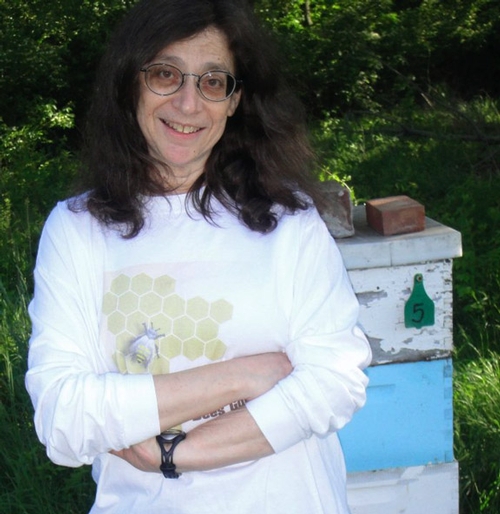- Author: Kathy Keatley Garvey

Well, they enabled it.
Take a look at one of May Berenbaum’s favorite honey recipes and you’ll know why she calls it “Apiscotti” or “Bee-Enabled Biscotti.”
Seven of the 12 ingredients (butter, honey, almond extract, nutmeg, cranberries, cherries, and almonds) depend on the pollination services of the honey bee, Apis mellifera.
May Berenbaum, professor and head of the University of Illinois Department of Entomology, kindly shared the recipe below.
You may know her as an entomologist, an administrator, a honey bee researcher, a book author, a columnist (American Entomologist), an opinion page writer (see her piece on bed bugs in the New York Times) a wife and a mother.
But not a beekeeper
“Although I’m an entomologist, I’m not in any sense of the word a beekeeper,” she writes in her newly published book, Honey, I'm Homemade: Sweet Treats from the Beehive Across the Centuries and Around the World, a project that benefits the University of Illinois Pollinatarium, the nation's first free-standing science outreach center devoted to flowering plants and their pollinators.
“At various intervals during my life I’ve been a bee landlord—other entomologists have kept bees on property I own—but I’ve never personally had a hive I could call my own or been involved in the production of honey. Truth be told, I’m a little afraid of honey bees—and not just because they can sting. The stings are a manageable risk. What I find unnerving about bees is how eerily talented they are and how profoundly different from the million-plus other species of insects.”
Berenbaum, a fellow of the American Academy of Arts and a member of the National Academy of Sciences, says that honey is a unique food “because of its power to evoke a particular time and place. Every time it is collected from a hive, honey takes on the nuanced flavors of a particular set of flowers--clover, orange blossoms, buckwheat, or others--at a certain point in time processed and stored by a particular group of bees. Honey is not just a snapshot of a time and place--it's the taste of a time and place, and it lends its flavors to the delectable baked goods and other treats found here.”
Indeed, we’re glad to see a project benefitting the Pollinatarium and heralding the humble honey bee. In pollination services alone, honey bees contribute approximately $20 billion annually to American agriculture. And the value of the 2008 honey crop totaled more than $226 million, Berenbaum points out.
Without the honey bee, there would be no Apiscotti—or most of the other foods we enjoy. And that would bee disastrous.
Here’s her recipe for Apiscotti.
Apiscotti (Bee-enabled Biscotti)
1/2 cup butter
1/2 cup sugar
1/4 cup honey
3 eggs
1/2 teaspoon salt
1 teaspoon almond extract
1/4 teaspoon nutmeg
2 teaspoons baking powder
2 1/2 to 3 cups flour
1/2 dried cranberries, chopped
1/2 cup dried cherries, chopped
1/2 cup blanched sliced almonds, chopped
Preheat oven to 350 degrees. Cream sugar and butter together; mix in honey until smooth. Beat eggs until frothy and then add salt, almond extract, nutmeg, and baking powder. Combine the sugar-butter mixture with the egg mixture. Add flour until dough is a consistency that can be handled. Refrigerate dough for 1 hour or more.
Divide chilled dough into 3 parts and flatten each third into a rectangle (use additional flour to make handling easier if necessary). Place a line at the center of each flattened section of dough and fill with chopped cherries, cranberries, and nuts. Fold the sides of each rectangle over to form a loaf, filling in center, and seal.
Place loaves on greased cookie sheet at 350 degrees for 45 minutes to 1 hour, or until golden brown. Slice on a slant while hot into 1/2-inch slices. For crispier slices, return to oven for 5–10 minutes, or until golden brown (the color of a honey bee).





